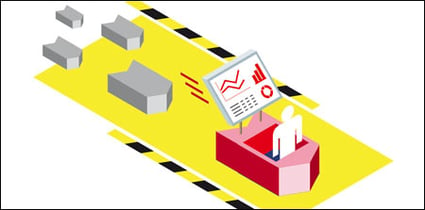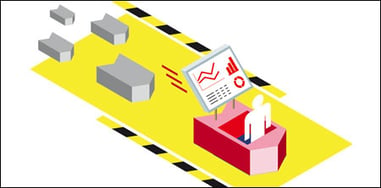Is the Automotive Supply Chain Ready for Electric Cars?
Jesse Kelber - October 01, 2019

 Remember the “paperless office?” Back in the early days of computing for the masses, and particularly after the invention of the public internet, it was all any of the pundits could talk about. They expounded on the wonders of digital this and online that, with the underlying theme being the elimination of physical copies of paperwork. It’s been well over two decades, and I don’t know about you, but my last office had a 30’ run of filing cabinets that certainly weren’t empty. Today, those same pundits are going into great detail about the “disruption” of the automotive industry that electric vehicles (EVs) signal. But is the shift to EVs really going to have that much of an impact? As with so many things, the answer is a resounding “it depends.”
Remember the “paperless office?” Back in the early days of computing for the masses, and particularly after the invention of the public internet, it was all any of the pundits could talk about. They expounded on the wonders of digital this and online that, with the underlying theme being the elimination of physical copies of paperwork. It’s been well over two decades, and I don’t know about you, but my last office had a 30’ run of filing cabinets that certainly weren’t empty. Today, those same pundits are going into great detail about the “disruption” of the automotive industry that electric vehicles (EVs) signal. But is the shift to EVs really going to have that much of an impact? As with so many things, the answer is a resounding “it depends.”
The Automotive Supply Chain: A Fundamental Shift is Coming
Let’s Start our examination at the raw materials end of the value chain. The batteries that power EVs contain lithium. In fact, it’s the battery industry in general that is driving the growth in mining economies in Central Asia and S. America, the primary locations where lithium is mined. That’s a far cry from the Middle East and the North Sea, where the majority of crude oil is found. This shift will mean changes to the transportation networks that supply these two essential raw materials, especially in the early days when there is still a huge demand for oil and yet a growing need for lithium as well. Some of the big players at this end of the chain are already expanding their fleets and establishing presences in these new regions in anticipation of these changes.
A further change to this end of the supply chain comes once the raw materials are extracted. Oil makes its way to refineries, often in the same country as the final stop on the journey, your gas tank. Lithium, on the other hand, must make its way to the battery factories, which are located primarily in Southeast Asia (South Korea, China, and Japan). Then the batteries must be transported to the car factories, which are located around the globe, before they can begin to power this revolution in electric cars. As an added factor, batteries need to be tended if they are left dormant for extended periods of time or they will lose their ability to hold a charge. This necessitates charging facilities at ports and employees trained in this task.
Parts and Production Are Not Immune to the Coming Changes
The automotive industry relies heavily on small manufacturing companies to produce a variety of the parts and pieces that go into internal combustion engines (ICEs), as well as the car overall. An average ICE contains upwards of 1,200 parts, while an average electric motor contains approximately 20. That’s 1/60th the number of parts in the engine alone. And the simplified drivetrains further reduce this parts count. Add in the machine tooling and production supporting the parts market, and the potential is there for widespread impact to this segment of the industry. However, many of these manufacturers are getting ahead of the curve by expanding their lineups to include the supporting machinery and parts required for EV production, alongside their traditional offerings. This advanced planning is in part due to better forecasting and demand planning capabilities offered by advanced analytics and AI-powered planning solutions.
At the production stage, many manufacturers are also beginning to plan ahead. The numbers were initially so small that it was difficult for the big players to retool and produce both EVs and ICEs at the same plant. This is what opened the door to smaller outfits, such as Tesla, to disrupt the industry. However, the big guys are making headway. One prominent German automaker, for example, is now able to produce many parts for both drivetrains side-by-side at a single plant thanks to far-ranging implementation of Industry 4.0 technology over the past few years. And in the US, GM is able to do the same for their Bolt electric and Volt hybrid drive vehicles, turning out both from the same facilities that make their other lines. With the reduction in parts required, they discovered that unused plant space could be transitioned into production lines for the more unique parts, while they were able to design and deploy flexible infrastructure that can pick up the slack in other areas.
But What About the Automotive Distribution Network?
Like each step before it, the distribution network will have to adapt. We discussed the dramatic drop in parts required to produce EVs, but further down the chain many logistics processes will experience major changes due to lower maintenance requirements. The dealership business model is heavily weighted to the service of the vehicles they sell—that’s where the money is. With no oil changes, simplified drivetrains, and simply fewer moving parts, EVs just don’t need the same level of service. Some dealers will have to adapt or die, others will refocus their efforts on maintenance for remaining ICEs, and others may have to pivot fully, for example by carrying a full line of electric transportation from scooters and bicycles to motorcycles and cars. Transporting lithium batteries brings a further set of complications. Not only is lithium highly flammable, therefore requiring the electrical systems in vehicles to be disabled for transport, but the batteries also require tending in order to maintain a charge. This means the logistics network will have to include charging facilities and workers specially trained in working on these systems (different requirements from the bare batteries mentioned earlier), and logistics planners will have to incorporate those same elements into their list of constraints when they build their planning documents.
So, is the automotive supply chain ready for electric vehicles, or not? Like I said at the beginning, it depends. Some aspects are ready to go, others will need some tweaks in order to survive. That said, it’s important to remember that the changes on the horizon are not going to happen all at once. Some media coverage of EVs makes it sounds like one day in the near future you won’t be able to find a gas station, just charging ports. That’s simply not the case. According to PwC Germany, by 2030 1 in 3 vehicles sold in the EU will be electric. That’s 33% of the vehicles sold, and that’s a decade out. This means the industry has time to adjust, adapt, and adopt the technologies they’ll need to remain relevant long into the coming automotive future.
LATEST POSTS
- Understand Circular Economy in The Manufacturing Industry
- How Can Industry 4.0 IT Integration Be Achieved Smoothly?
- The Significance of Order Sequencing in Discrete Manufacturing
- How to improve your Supply Chain Management: The Power of Control Towers
- Optimizing Human Resource Scheduling in Manufacturing: A Technological Approach



